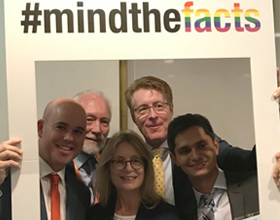
The CEOs of Australia’s leading youth mental health organisations will unite in an unprecedented show of support for marriage equality on Wednesday 18 October as they bring their #mindthefacts campaign to Canberra.
At a special drop-in session in Parliament House, the CEOs of Black Dog Institute, headspace, ReachOut, Brain and Mind Centre at University of Sydney and Orygen, the National Centre of Excellence in Youth Mental Health will urge Australia’s political leaders to take note of the overwhelming body of evidence showing the negative effects of discrimination on young LGBTIQ people’s mental health.
The #mindthefacts campaign has invited young LGBTIQ people to share their experience and concerns about the divisive public debate on the postal survey. The CEOs will also call upon politicians to get behind the #mindthefacts campaign by taking a picture in a dedicated selfie-booth.
“Dozens of studies, systematic reviews and meta-analyses, published over the last several decades from countries around the world all point to the same conclusion: when LGBTIQ people’s rights are restricted, their mental health suffers,” said Professor Helen Christensen, Director of Black Dog Institute, speaking on behalf of the campaign.
“We want to shine a spotlight on the facts so that our policymakers and everyday Australians are armed with the tools to make an evidence-informed vote.
“Evidence from international studies shows that same-sex couples report higher levels of health in jurisdictions with marriage equality[1]. It’s time for Australia to act on the facts to help change thousands of young LGBTIQ lives for the better.”
As the postal survey enters its final weeks, the #mindthefacts campaign will today launch a campaign page featuring key local and international research findings on LGBTIQ people’s mental health and marriage equality. The microsite also includes resources to help same-sex attracted people build resilience and cope with distressing coverage, and factsheets for starting safe conversations to encourage help-seeking for those struggling with their mental health.
“For young LGBTIQ people there is no escaping the negativity of this postal survey debate. Sadly, it has been draining and often dehumanising,” said Professor Christensen.
“It’s incumbent on us as mental health organisations to provide the information people need to look after themselves and others at this critical time.”
The event comes as youth mental health service ReachOut revealed an increase in service demand following the postal survey announcement. Since the end of August, access to LGBTIQ and gender-related content on ReachOut.com has increased by 20 percent.
KEY FACTS
- LGBTI young people are twice as likely to be diagnosed with a mental health condition, six times more likely to have suicidal thoughts and five times more likely to make an attempt on their life than their heterosexual peers[2][3].
- Stigma and prejudice have been associated with a shorter life expectancy of approximately 12 years for sexual minorities living in high-prejudice communities[4].
- Harassment or abuse against LGBT people is an indicator of poorer mental health, with those experiencing harassment or abuse reporting higher levels of psychological distress[5].
- Daily exposure to negative campaign messages on the rights of same-sex couples is linked to negative consequences for their psychological and relational wellbeing[6].
- Compared to their heterosexual peers, same-sex attracted people are 14 times more likely to attempt suicide, are twice as likely to experience anxiety disorders and are three times more likely to experience affective disorders[7][8].
- In areas where marriage equality is not legal, same-sex attracted people have lower mental health outcomes than in areas where it is.[9]
Visit the #mindthefacts microsite.
About #mindthefacts
#mindthefacts is a national campaign launched in September by five of Australia’s leading youth mental health organisations: Black Dog Institute, headspace, ReachOut, Brain and Mind Centre at the University of Sydney and Orygen, The National Centre of Excellence in Youth Mental Health.
The campaign asks Australians to consider the real and devastating link between discrimination and negative mental health impacts for young LGBTIQ people when voting in the marriage equality postal survey. The campaign follows urgent high-level talks between the mental health groups after
[1] Lennox Kail B et al, ‘State-Level Marriage Equality and the Health of Same-Sex Couples’. American Journal of Public Health. Vol. 105, 2015, p. 1101-1105.
[2] S. Morris, ‘Snapshot of Mental Health and Suicide Prevention Statistics for LGBTI People and Communities’.National LGBTI Health Alliance, 2016
[3] K.H. Robinson et al., ‘Growing Up Queer: Issues Facing Young Australians Who Are Gender Variant and Sexuality Diverse’. Young and Well Cooperative Research Centre, 2014.
[4] M.L. Hatzenbuelher et al, ‘Structural stigma and allcause mortality in sexual minority populations’. Social Science & Medicine. Vol. 103, 2014, p. 33-41.
[5] W Leonard et al, ‘A closer look at Private Lives 2: Addressing the mental health and well-being of lesbian, gay, bisexual and transgender (LGBT) Australians’. Monograph Series No. 103. The Australian Research Centre in Sex, Health & Society, La Trobe University: Melbourne, 2015.
[6] D.M. Frost & A.W. Fingerhut, Daily exposure to negative campaign messages decreases same-sex couples’ psychological and relational well-being. Group Processes & Intergroup Relations. 2016; 19(4): 477-492.
[7] Australian Bureau of Statistics (2007) National Survey of Mental Health and Wellbeing: Summary of Results. 4326.0. Australian Government, Canberra.
[8] G. Rosenstreich, ‘LGBTI People Mental Health and Suicide’. Revised 2nd Edition. National LGBTI Health Alliance, 2013.
[9] M.L. Hatzenbuehler et al, ‘The impact of institutional discrimination on psychiatric disorders in lesbian, gay, and bisexual populations: a prospective study’. American Journal of Public Health. vol. 100, no. 3, 2010, p 452-459.